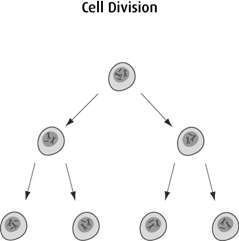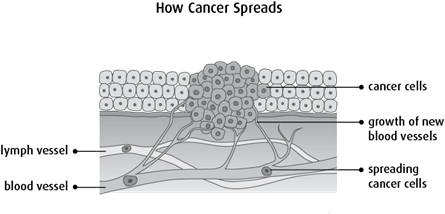Do Cancer Cells Continue to Perform Their Intended Function
Our bodies are made up of trillions of cells grouped to form tissues and organs.
But when there is a change in our

Diagram of cell division
But cancer cells are different. Cancer cells have gene mutations that turn the cell from a normal cell into a cancer cell. These gene mutations may be inherited, develop over time as we get older and genes wear out, or develop if we are around something that damages our genes, like cigarette smoke, alcohol or ultraviolet (UV) radiation from the sun.
A cancer cell doesn't act like a normal cell. It starts to grow and divide out of control instead of dying when it should. They also don't mature as much as normal cells so they stay immature. Although there are many different types of cancer, they all start because of cells that are growing abnormally and out of control. Cancer can start in any cell in the body.

Diagram of how cancer grows
But as a tumour grows, it needs more blood to bring oxygen and other nutrients to the cancer cells. So cancer cells send signals for a tumour to make new blood vessels. This is called angiogenesis and it is one of the reasons that tumours grow and get bigger. It also allows cancer cells to get into the blood and spread more easily to other parts of the body. There is a lot of research that is looking at using drugs that stop blood vessel growth (called angiogenesis inhibitors), causing a tumour to stop growing and even shrink.

Diagram of how cancer spreads
Cancer can also spread from where it first started to other parts of the body. This process is called metastasis. Cancer cells can metastasize when they break away from the tumour and travel to a new location in the body through the blood or lymphatic system.
Most cancers have a tendency to spread to certain areas of the body. This has helped doctors develop staging systems that are used to classify cancers based on information about where the cancer is in the body and if it has spread from where it started. Many cancers follow a staging system from 1 to 4 that is usually given in Roman numerals I, II, III or IV. Knowing how a cancer spreads and where a cancer may spread helps doctors predict how the cancer will grow. This also helps them plan treatment and give appropriate supportive care.
Cancer can spread anywhere in the body, but it's most likely to spread to lymph nodes, bones, the brain, the liver or the lungs.
Cancer sometimes comes back after treatment. This is called a recurrence. Even if one cancer cell is left behind, it can grow and divide to become a new tumour. A new tumour can start to grow in the same area of the body where the cancer first started, or the cancer may have spread through the blood or lymphatic system to another part of the body, where it grows into a new tumour. This is why doctors sometimes use another treatment right after the first treatment, such as giving chemotherapy after surgery. This is called adjuvant therapy. The goal of adjuvant therapy is to help prevent the cancer from coming back in case some cancer cells are left behind in the body.
In some cases, treatment may stop working (become resistant) so cancer cells are no longer being destroyed. So cancer that was shrinking or had disappeared may start to grow again and get bigger. This can happen when the genes inside cancer cells mutate. Some gene mutations make cancer cells resistant to chemotherapy and other drug treatments. If you become resistant to a treatment, your doctor may suggest that you try another one.
Many cancers can be cured with treatment. But cancer that is thought to be cured can still come back even years later. This is why some doctors prefer to say that the cancer is in remission. Remission means there are fewer signs and symptoms of a disease (such as cancer) or that they have completely gone away.
Source: https://cancer.ca/en/cancer-information/what-is-cancer/how-cancer-starts-grows-and-spreads
0 Response to "Do Cancer Cells Continue to Perform Their Intended Function"
Enregistrer un commentaire